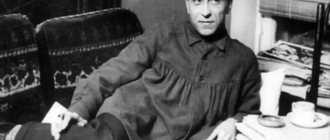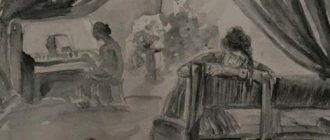- Essays
- On literature
- Other
- Analysis of Andersen's fairy tale The Little Match Girl
“The Little Match Girl” is a famous Christmas story by H.H. Andersen. The main character of the story is a little beggar girl who is forced to sell matches on the night before New Year. Her family was extremely poor, therefore, despite the severe cold, she could not return home until she sold all the matches. Nobody, however, bought them. In order not to freeze completely, the girl slowly began to light matches. In the flickering of their fire she saw wonderful visions of scenes of the Nativity. In one of them, a girl saw her dead grandmother and asked to take her with her to heaven. In the morning, people discovered the body of a girl frozen to death.
This story shows readers all the cruelty and hostility of the outside world. The main character is just a weak child who suffers great need. To provide for her family, she sells matches on the street at night in the bitter cold. However, the passers-by who fill the streets pay absolutely no attention to her and do not try to help. If each of them had bought at least a match, the girl would have returned home that night. However, would this bring her happiness?
The story mentions that the girl is afraid that her father will kill her if she does not sell the matches. Poverty and the resulting cruelty reign in the family. It turns out that the girl is not safe and loved even among the people closest to her, her family. It is logical to assume that even if the girl had survived that night, the next day would not have brought her peace and joy - poverty and cruelty were an integral part of her world. And Andersen perfectly understood how hopeless the heroine’s situation was - and she, of course, is not an isolated character, but a typical one. The author made death the way out for her, but not just oblivion, but a happy heavenly kingdom. If kindness and justice cannot triumph in the real world, it must at least reign in heaven, after death.
The time of action in the story further emphasizes the theme of injustice and cruelty of the world. New Year's Eve is a bright, festive time in which it is customary to show kindness and love. Here, however, we see a completely opposite picture. The author introduces an antithesis for a reason, because this contrast maximally emphasizes the horror of the situation, draws the reader’s attention to the problem, removes the veil from his eyes and plunges him into the cruelty of the real world. Thus, Andersen emphasizes that people must become kinder and more attentive to each other, so that there are as few weak, defenseless people with a difficult lot left in the world as possible.
Other works: ← Analysis of Andersen's fairy tale Thumbelina ↑ Others Analysis of the work The Mistress of the Copper Mountain Bazhova →
History of creation
As a child, the writer suffered hunger, cold and hardship. His mother, whose name was Ani-Marie Andersen, was practically poor, and the boy early began to think about what qualities distinguish some people from others. Around him he saw people endowed with different character traits, including the following:
In such conditions, the personality of G. H. Andersen was formed, and later this became the basis for his works. Many of them are imbued with hidden melancholy and bitterness, and in the story “The Little Match Girl” kindness and cruelty go side by side.
The reason for writing was one story. The almanac Danske Volkskalender was published in Denmark. One day, its founder sent Andersen several drawings carved on wood. He asked me to choose one of the plots and write a story for it. The writer was touched by the image of the poor little girl. She sat and held a box of sulfur matches in her hands. A few more pieces spilled into the apron.
The author of the engraving was Johann Lundby, and the girl depicted on it was a seller of sulfur matches. Thus, Andersen wrote a text accompaniment to the picture - a short Christmas story, which is now often called a fairy tale. The work was created in 1845. It was translated into Russian by P. Ganzen and A. Ganzen. Based on the fairy tale, performances are staged, scripts are created and short films are made.
Literary direction and genre
The genre of the Christmas story presupposes the miraculous transformation of the hero, his finding happiness at Christmas, when miracles happen. But “The Little Match Girl” is one of the writer’s saddest works. The heroine dies, there is no hope for the transformation of her life, but this is from the point of view of the average person. And the narrator is a Christian, a romantic, for him the end of the fairy tale is happy.
For a romantic, the ideal is unattainable. All the visions that pass before the eyes of the freezing girl are a beautiful world that she dreamed of all her life, but was able to achieve only after death.
The image of the heroine
The main character of this work is a poor girl who has no mother, but only a father. She is beautiful, but she doesn't know it. Her clothes are frayed and shabby, her blond hair falls to her shoulders. She doesn't have a scarf or shoes. This image is typical of fairy tales and stories by Hans Christian Andersen.
The heroine has no name, and there are 2 reasons for this. The first is that the author wanted to show not a specific child, but everyone who found themselves in the same or similar situation.
There were a lot of poor people in Denmark in those years , and poverty forced them to treat each other with indifference. Parents sometimes did not have money for food or the strength to feel sorry for and console their children.
On the other hand, the absence of a name shows that no one in the world needs this child. The poor thing will die, and the next day no one will remember about her. Only God and grandmother love her. Without calling the heroine by name, the author thereby separates the girl from the townspeople. There are other people, and then there is her. They, who live warm and well-fed, cannot understand the beauty she saw in the near-death phenomena, and if they knew about this, they would think that there was nothing special about the roast goose and the stove.
Plot and composition
The two-page story reveals all the circumstances of the girl’s life. The reader learns about some facts of her biography from the details. For example, a little girl put on shoes that her mother used to wear. Obviously, the mother is now dead.
The world of poverty in which the little match seller lives is separated from the world of wealth, which is hostile to the girl. She loses her shoes, her only inheritance, frightened by the carriages rushing at full speed. But the world of the poor is also hostile. He is closer, the girl comes into contact with him and because of this she sees his absurdity. In the world of human relations, the laws of nature reign, where the strongest survive. The boy selects a wooden shoe to make a cradle out of it for future children. The absurdity of this act and the boy's idea is obvious. A child accustomed to poverty tries to resist circumstances by storing things for all occasions.
In the girl’s dying visions, all her needs are realized, first physical (warmth and satiety), then spiritual (cozy security and love). In the first vision, the match turns into an amazing candle, and the girl warms herself by the stove. In the second, the girl finds herself at a rich table, and the roast goose himself comes to feed her. The third vision takes the girl to a luxurious Christmas tree.
The girl comes to terms with the fact that the visions disappear when the match goes out. But she is not ready to lose again the recently deceased grandmother who appeared in the vision. Love overcomes the fear of punishment, and the girl lights all the matches at the same time.
At the end of the story, the two worlds regain their borders. The girl’s body remains to the earthly world, her soul belongs to heaven.
Popular topics today
Tolstoy had good reasons for giving his “colleague” such a nickname. And this is not an offensive “name” at all. On the contrary...
In the wonderful fairy tale “Wild Swans” we see all the courage and heroism of young Eliza. The girl suffered from hellish torment in the process of sewing shirts from nettles and was ready to sacrifice her life for the sake of her brothers.
Each student has his own ideas about the ideal of the school. To be honest, the model of an ideal school among my peers is quite strange. In the dreams of all my friends, school is an institution
This painting was presented to the viewer in 1871. It caused a resonance and a storm of emotions. The artist created it after the death of his little daughter.
Source
Literary direction and genre
The genre of Andersen's work "The Little Match Girl" is a Christmas story. It is characterized by miracles that happen to people on Christmas Eve, but we are talking about New Year's Eve. Andersen was a believer and sincerely believed that after death a person will have another life, happy or unhappy, depending on how much he had to suffer in this world.
For modern readers, the girl died, and for the contemporaries of Hans Christian Andersen, a miracle happened to her, because the best thing, they believed, happens to a person in heaven, when the Lord takes him to himself. This is typical of the genre chosen by the Danish storyteller. The main and secondary characters of the work:
Composition and plot
The girl's whole life is shown in a story, the length of which fits into 2 pages. The author does not directly reveal some details, but points to them. For example, a girl wears her mother's shoes. It is not difficult to understand that she has already died.
The heroine of the story makes money by selling matches. She lives in a hostile world, where neither the rich nor the poor like herself show sympathy for her. To feed herself, she sells sulfur matches, but not every day is successful. The girl had not eaten anything all day and was very cold, and to top it all off, she lost her shoes when she rushed away from a passing carriage.
In the city, whose life Andersen describes, there is no place for mercy and compassion; the laws of nature reign there, which means that the one who is stronger survives. Those who should have understood how hard it is for the little one also show indifference to her. When the boy takes the heroine’s shoes, he doesn’t think about the fact that now she will remain barefoot. In the first place for him is the opportunity to make a cradle for the children out of a shoe.
This is how the author shows the cruel reality: from an early age, children learn to survive and store everything they can for future use. In fact, a shoe will not make a cradle, and the boy’s action is absurd. Using this technique, the writer shows how absurd the actions and judgments of people driven to despair by poverty can be.





